Is It Safe to Eat Uncooked Rice
Eating uncooked rice isn't safe and can pose serious health risks. You're exposing yourself to potential bacterial contamination, particularly from Bacillus cereus, which can cause food poisoning. Raw rice also contains anti-nutrients like lectins that interfere with digestion and nutrient absorption. The hard texture may damage your teeth and jaw. Long-term consumption has been linked to increased arsenic levels, raising cancer and cardiovascular disease risks. To avoid these dangers, always cook rice thoroughly using proper techniques. Store cooked rice correctly to prevent bacterial growth. If you're looking for alternatives, consider other cooked grains or rice-based snacks. The following information will equip you with essential knowledge for safe rice consumption.
This post may contain affiliate links. If you make a purchase through these links, I may earn a commission at no additional cost to you. Additionally, portions of this post may be generated using artificial intelligence (AI) technology. While we strive for accuracy, please be aware that AI-generated content may not always be perfect and should be fact-checked when necessary.
The Spatula Scoops
- Eating uncooked rice can lead to food poisoning from Bacillus cereus bacteria, causing nausea, vomiting, and diarrhea.
- Raw rice contains anti-nutrients like lectins that interfere with digestion and nutrient absorption, potentially causing nutritional deficiencies.
- Long-term consumption of uncooked rice may increase arsenic exposure, raising risks of cancer and cardiovascular diseases.
- The hard texture of raw rice can damage tooth enamel and cause jaw strain, increasing the risk of dental issues.
- Proper cooking techniques significantly reduce health risks associated with raw rice consumption and improve nutrient bioavailability.
Risks of Consuming Raw Rice
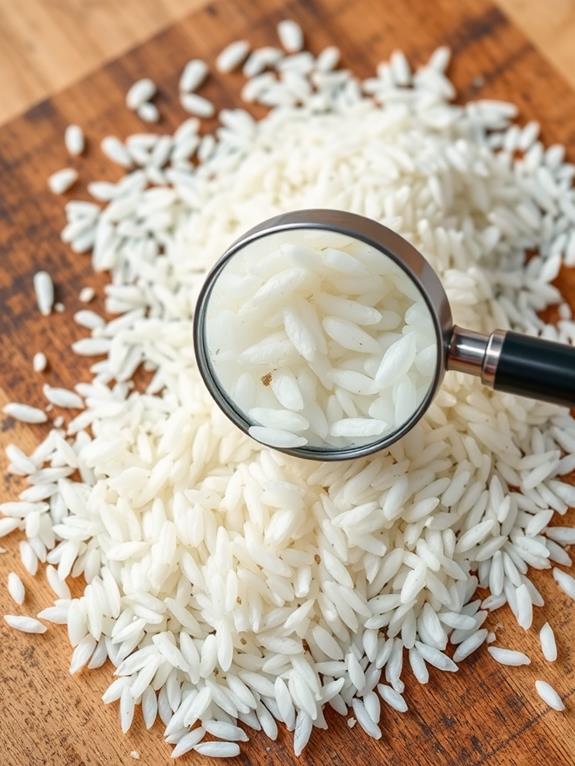
Consumption of uncooked rice poses several health risks that shouldn't be overlooked. When you eat raw rice, you're exposing yourself to Bacillus cereus, a bacteria responsible for thousands of food poisoning cases annually in the U.S. This pathogen can cause severe gastrointestinal issues, including nausea, vomiting, and diarrhea. Additionally, raw rice can contain anti-nutrients similar to those found in quinoa, which might interfere with digestion and nutrient absorption, affecting overall health nutritional benefits of grains.
Uncooked rice contains lectins, proteins that interfere with nutrient absorption and may damage your gut walls. These compounds can lead to significant gastrointestinal distress, potentially impacting your overall health. Furthermore, the hard texture of raw rice can cause dental damage, increasing your risk of tooth decay and jaw strain.
It's important to note that even cooked rice can be problematic if stored improperly. Bacillus cereus spores can survive cooking and multiply rapidly at room temperature, leading to food poisoning. Long-term consumption of raw rice also exposes you to elevated arsenic levels, which have been linked to serious health risks such as cancer and cardiovascular disease. Given these potential dangers, it's essential to properly cook and store rice to minimize health risks associated with its consumption.
Bacterial Contamination and Food Poisoning
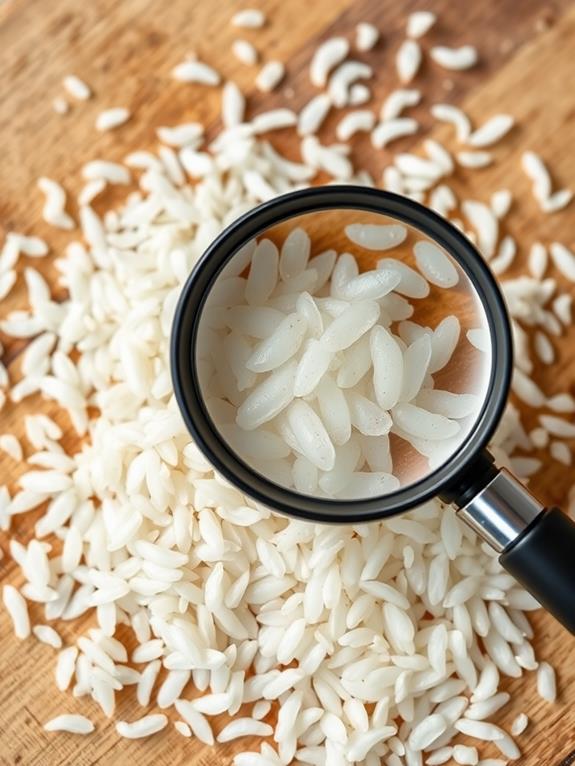
Bacterial contamination stands out as a major concern when it comes to raw rice consumption. You might not realize it, but uncooked rice can harbor harmful bacteria, particularly Bacillus cereus. This pathogen is responsible for thousands of food poisoning cases annually in the U.S., with nearly half of commercial rice samples testing positive for its presence. Similar to how newly cultivated corn exhibits growth potential, uncooked rice poses risks due to its potential to carry these harmful bacteria.
When you consume raw rice, you're exposing yourself to potential gastrointestinal issues. Bacillus cereus forms heat-resistant spores that can survive cooking, making proper food handling vital. If you don't store cooked rice correctly, these spores can multiply, leading to contamination. Symptoms of food poisoning from this bacteria can appear quickly, often within 1 to 6 hours after eating contaminated rice.
It's essential to understand that cooking rice thoroughly is your best defense against these risks. Uncooked rice poses significant health threats due to potential contamination, and proper preparation is key to eliminating the risk of Bacillus cereus and other harmful bacteria. By ensuring your rice is fully cooked and stored correctly, you'll greatly reduce your chances of experiencing food poisoning from this common staple.
Digestive Issues From Uncooked Rice
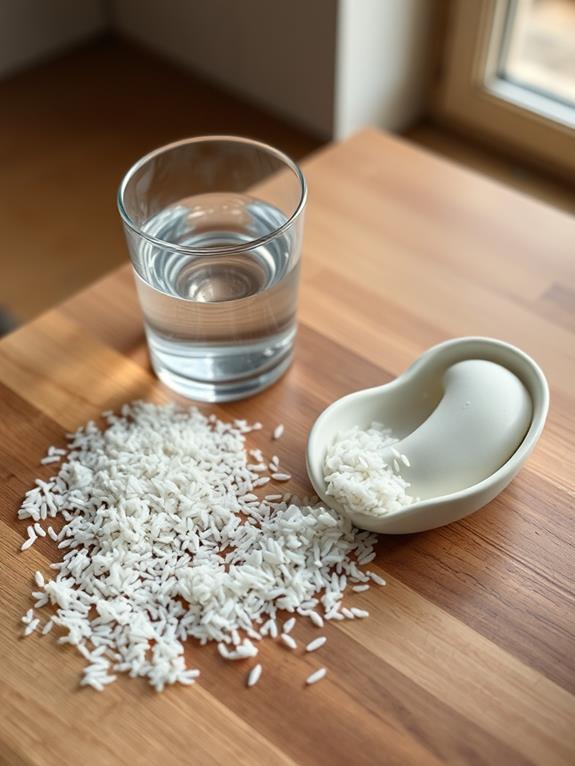
You'll want to be cautious about consuming uncooked rice, as it can lead to several digestive issues. Eating raw rice may cause gastrointestinal distress, including symptoms like nausea, vomiting, diarrhea, and abdominal pain due to the presence of lectins, which are proteins that can interfere with your body's ability to absorb essential nutrients. Additionally, incorporating nutrient-rich foods like Bragg Nutritional Yeast in your diet may help optimize nutrient absorption, reducing the negative impact of other less digestible foods. Furthermore, the lectins in uncooked rice can potentially damage your gut walls over time, contributing to longer-term digestive problems and even increasing the risk of certain diseases.
Gastrointestinal Distress Symptoms
Eating uncooked rice can wreak havoc on your digestive system. When you consume raw rice, you're exposing yourself to lectins, proteins that your body may struggle to digest properly. These lectins can trigger a range of gastrointestinal distress symptoms, including nausea, vomiting, and diarrhea. It's not just lectins you need to worry about; raw rice also contains high levels of resistant starch, which can lead to constipation, bloating, and abdominal pain.
The consequences of eating uncooked rice don't stop there. You might experience severe symptoms like bowel obstruction or perforation due to the hard texture of raw rice grains. Your digestive system simply isn't equipped to process these tough, uncooked kernels effectively. Furthermore, the act of chewing raw rice can strain your jaw muscles and damage your tooth enamel, potentially increasing your risk of tooth decay. Long-term consumption of raw rice and exposure to undigested lectins has been linked to more serious gastrointestinal disorders, such as celiac disease, and may even contribute to the development of colorectal cancer. It's clear that the risks of eating uncooked rice far outweigh any perceived benefits.
Lectin-Induced Digestive Problems
Lectins in uncooked rice are a major culprit behind digestive issues. These proteins can wreak havoc on your gastrointestinal system, causing a range of problems from nausea to diarrhea. When you consume raw rice, you're exposing yourself to high levels of lectins that can inhibit the repair of damaged cells in your gut, potentially leading to long-term gastrointestinal issues.
If you're already dealing with digestive problems, eating uncooked rice can exacerbate your symptoms. It's particularly concerning for those with conditions like celiac disease. Even if you don't have a pre-existing condition, raw rice can interfere with your body's ability to absorb nutrients properly, compounding digestive discomfort.
While cooking rice considerably reduces lectin levels, it's essential to recognize that not all lectins are eliminated. This means that even undercooked rice can cause some gastrointestinal distress. To minimize your risk of lectin-induced digestive problems, always opt for fully cooked rice as a healthier option. By ensuring your rice is thoroughly cooked, you'll be taking a vital step towards protecting your digestive health and avoiding unnecessary discomfort.
Nutrient Absorption Interference
Three major nutrients are at risk when you consume uncooked rice: calcium, iron, and other essential minerals. Raw rice contains lectins, proteins that can interfere with nutrient absorption in your digestive tract. These lectins bind to the lining of your intestines, making it harder for your body to absorb vital nutrients.
When you eat uncooked rice, you're not only missing out on the health benefits of properly prepared grains but also potentially causing gastrointestinal issues. Lectins can lead to nausea, vomiting, and diarrhea due to their undigestibility in your gut. Over time, this interference with nutrient absorption can lead to deficiencies, particularly in calcium and iron.
It's important to note that cooking rice considerably reduces lectin levels. This process makes the nutrients more bioavailable and prevents potential digestive problems. By eating cooked rice instead of uncooked rice, you're ensuring better nutrient absorption and reducing the risk of gastrointestinal distress. Remember, while raw rice might seem like a convenient snack, it's always best to prioritize your health by properly preparing your grains.
Nutrient Absorption and Raw Rice
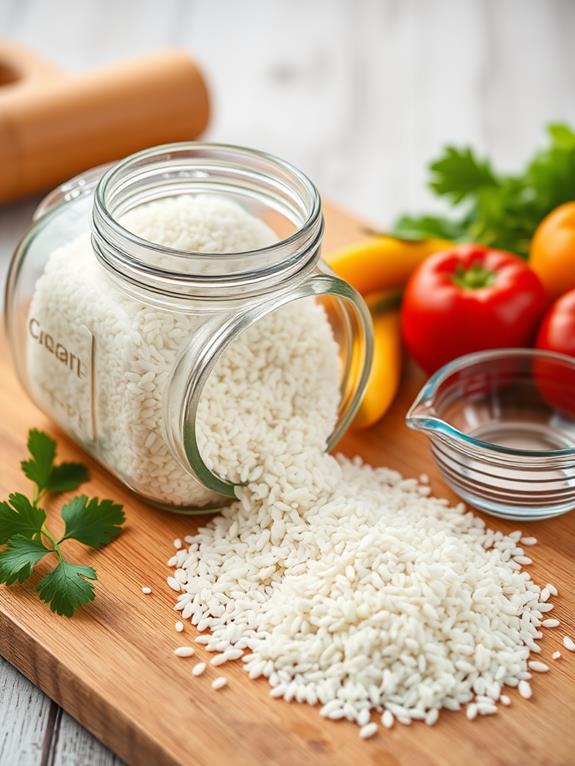
Nutrient Absorption and Raw Rice
From a nutritional standpoint, consuming raw rice isn't advisable. Eating uncooked rice can markedly hinder your body's ability to absorb essential nutrients. Raw rice contains lectins, which are anti-nutrients that interfere with the absorption of important minerals like calcium and iron in your digestive system. Additionally, factors like cooking methods can enhance nutrient availability, as seen with other foods such as raw Brussels sprouts. These lectins can also lead to gastrointestinal issues, causing symptoms such as nausea and diarrhea, which may further impair nutrient absorption.
When you cook rice, you're not just making it more palatable; you're also improving its nutritional value. Cooking notably reduces lectin levels, enhancing your body's ability to digest and absorb nutrients effectively. Additionally, raw rice contains high levels of resistant starch, which can contribute to digestive problems and further impede nutrient absorption.
Proper Rice Cooking Techniques
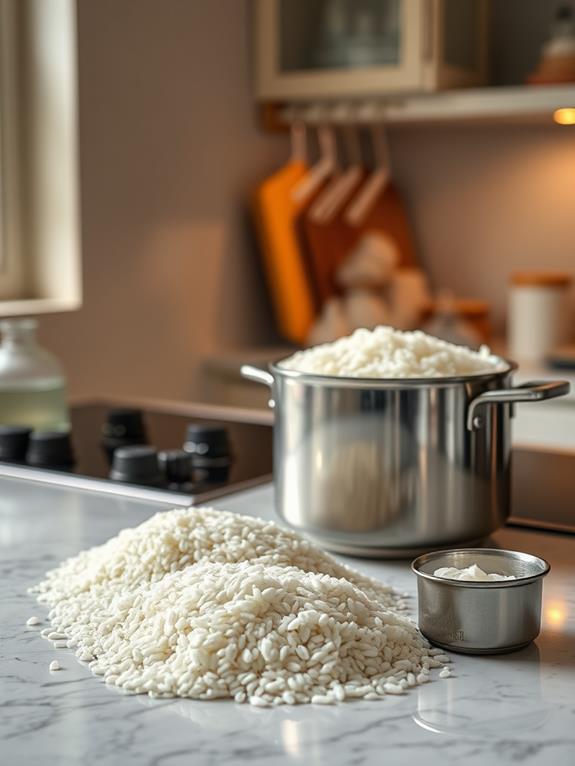
Safety is paramount when it comes to cooking rice properly. Raw or undercooked rice can harbor harmful bacteria like Bacillus cereus, which can cause foodborne illness. To reduce the risk, you'll need to follow proper cooking techniques. A reliable kitchen tool such as the professional-grade blender can help in preparing sauces or dressings to accompany your rice dishes.
Start by thoroughly rinsing your rice in a sieve until the water runs clear. This removes excess starch, preventing clumping during cooking. Use a ratio of 1 cup of rice to 1½ cups of boiling water, and simmer for at least 20 minutes. Adjust cooking times for different rice varieties to ascertain it's fully cooked before consumption.
To avoid undercooking, use a rice cooker or stovetop method for consistent results. Always make certain your cooked rice reaches and maintains a serving temperature above 140°F (60°C) to inhibit bacteria growth.
Safe Storage of Cooked Rice
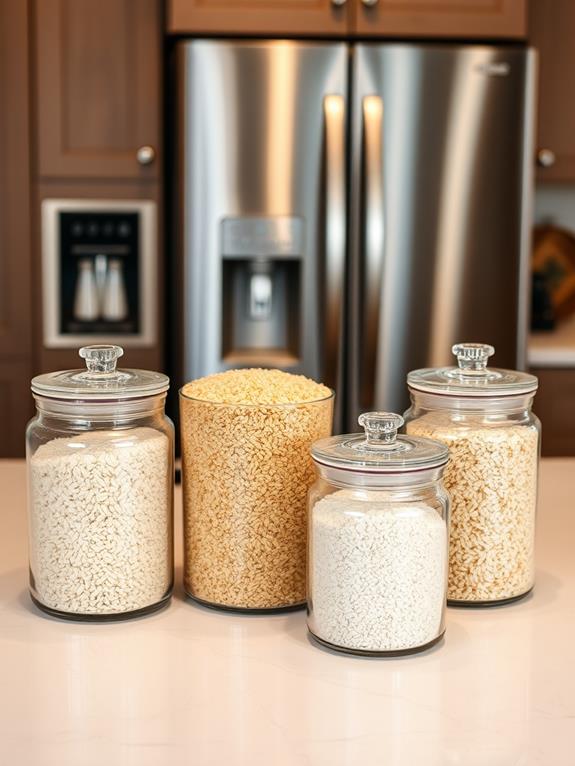
When it comes to storing cooked rice safely, you'll need to master proper cooling techniques and refrigeration best practices. It's important to make sure that the rice is kept fresh, similar to how PetSafe ceramic water fountain filters help maintain clean drinking water for pets. It's essential to cool your rice quickly and store it in the refrigerator within an hour of cooking to avoid the temperature danger zone, where bacteria thrive. By following these guidelines, you'll greatly reduce the risk of foodborne illness and make sure your cooked rice stays safe to eat for several days.
Proper Cooling Techniques
Proper cooling and storage of cooked rice are vital for preventing foodborne illnesses. To guarantee your rice stays safe to eat, you'll need to follow proper cooling techniques. After cooking, cool your rice quickly by spreading it in shallow containers. This method helps prevent bacterial growth by rapidly lowering the temperature. You should aim to refrigerate cooked rice within two hours of preparation.
It's important to avoid leaving your rice in the temperature danger zone (40°F – 140°F) for more than two hours. This range is ideal for bacterial growth, which can lead to foodborne illnesses. Once cooled, store your rice in airtight containers in the refrigerator. It'll stay fresh for 3-4 days when properly stored.
If you want to extend its shelf life, you can freeze cooked rice for up to six months. However, make sure to cool it first before freezing. Regularly check your stored rice for signs of spoiling, such as off-odors or changes in texture. By following these guidelines, you'll minimize the risk of consuming unsafe rice and guarantee your meals remain both delicious and safe to eat.
Refrigeration Best Practices
Building on proper cooling techniques, refrigeration plays a key role in keeping cooked rice safe for consumption. You'll want to store your cooked rice in airtight containers within an hour of cooking to prevent harmful bacteria like Bacillus cereus from growing. Maintain your refrigerator temperature below 41°F (5°C) to guarantee the safety and quality of stored rice.
Remember, leftover cooked rice should be consumed within 3 to 4 days when refrigerated. This timeframe helps minimize the risk of foodborne illness. If you're not planning to eat the rice within this period, consider freezing it. Frozen cooked rice can last up to 6 months while maintaining safety and flavor.
Here's a quick reference guide for safe rice storage:
| Storage Method | Temperature | Duration | Safety Tips |
|---|---|---|---|
| Refrigeration | Below 41°F | 3-4 days | Use airtight containers |
| Freezing | 0°F or below | Up to 6 months | Label with date |
| Room Temperature | N/A | 1 hour max | Cool quickly |
When you're ready to eat your stored rice, always reheat it to an internal temperature of at least 165°F (74°C). This step kills any potential bacteria that may have formed during storage, guaranteeing your rice is safe to eat.
Avoiding Temperature Danger Zone
Without a doubt, understanding the temperature danger zone is vital for safely storing cooked rice. The danger zone spans from 40°F (4°C) to 140°F (60°C), where bacterial growth thrives if food is left within this range for too long. To guarantee your cooked rice remains safe to eat, you'll need to cool it properly and store it quickly.
Here's how you can avoid the temperature danger zone:
- Cool your rice immediately after cooking using shallow containers.
- Refrigerate cooked rice within 1 hour of preparation.
- Store rice at or below 40°F (4°C) to prevent bacterial growth.
If you cool improperly or leave cooked rice at room temperature for extended periods, you're risking food safety. Remember, bacteria multiply rapidly in the danger zone, potentially leading to foodborne illness. It's imperative to move your rice through this zone quickly when cooling. If you can't refrigerate cooked rice promptly, it's best to discard it. By following these guidelines, you'll greatly reduce the risk of bacterial contamination and guarantee your cooked rice remains safe for consumption.
Alternatives to Raw Rice Consumption
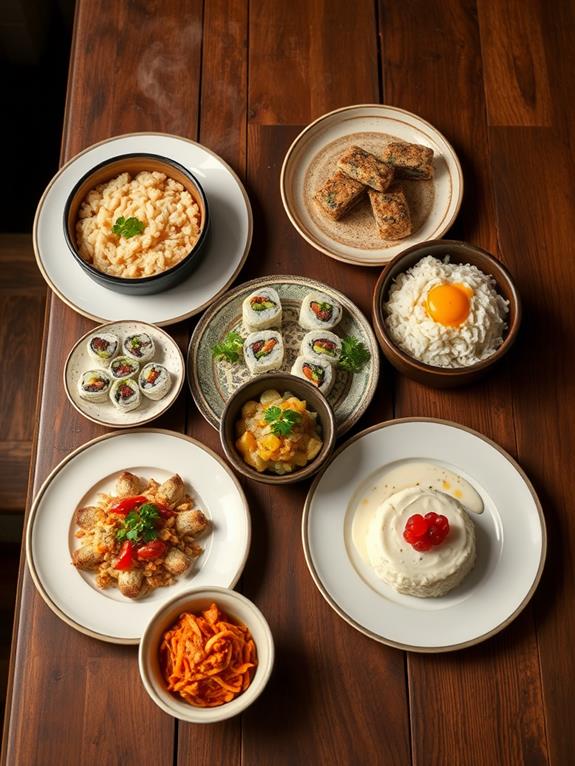
When considering alternatives to raw rice consumption, you'll find a wealth of options that are both safe and nutritious. Instead of risking your health with uncooked grains, try incorporating cooked whole grains like quinoa, barley, or bulgur into your meals. These alternatives provide essential nutrients without the bacterial threats associated with raw rice. For enhanced flavor in your dishes, consider adding freshly grown herbs like basil or parsley, which can elevate the taste profile while offering significant nutritional benefits, as they are high in vitamins and antioxidants popular kitchen herbs.
For a healthier rice option, switch to brown, black, red, or wild rice varieties. They're packed with dietary fiber, antioxidants, and vitamins, offering superior nutritional value compared to raw rice. If you're craving a crunchy alternative, reach for puffed rice or rice cakes. These snacks satisfy your desire for texture without the health risks of uncooked grains.
When preparing rice-based dishes, experiment with combinations of cooked grains, legumes, and vegetables. This approach guarantees a nutritious meal while eliminating the hazards of raw rice consumption. For those seeking safe rice options, consider premium brands like Veer Overseas, which offer cooked basmati rice products that retain nutrients and minimize bacterial risks. By exploring these alternatives, you'll enjoy flavorful, healthy meals without compromising your well-being.
Frequently Asked Questions
What Happens if I Eat Uncooked Rice?
Did you know that 1 in 5 people have tried eating uncooked rice? If you eat uncooked rice, you're exposing yourself to several risks. You'll likely experience gastrointestinal distress due to lectins and potential food poisoning from bacteria like Bacillus cereus. You're also risking dental damage, as the hard grains can harm your tooth enamel. Additionally, it might indicate pica, a disorder linked to consuming non-nutritive substances. To stay safe and maximize nutrient absorption, it's best to always cook your rice thoroughly.
Why Do People Eat Raw Rice?
You might wonder why people eat raw rice. There are several reasons: cultural traditions, where it's seen as a snack or health food; pica, an eating disorder causing cravings for non-food items; dietary trends promoting raw grains for supposed health benefits; and culinary experimentation for unique textures and flavors. Some pregnant women or children may crave raw rice due to nutritional deficiencies. However, it's vital to recognize that eating raw rice can pose health risks and isn't generally recommended.
What Do You Do if Rice Is Not Fully Cooked?
Ah, you've discovered the joys of crunchy rice! Just kidding, don't eat that. If your rice isn't fully cooked, you'll need to return it to the heat. Add a splash of water and continue cooking until it's tender. Make certain it reaches an internal temperature of 140°F (60°C) to kill any harmful bacteria. You can use a steamer or add boiling water for better cooking distribution. Remember, undercooked rice can cause digestive issues, so it's important to cook it thoroughly.
How Do I Stop Eating Raw Rice?
To stop eating raw rice, you'll need to address the root cause of your cravings. Start by identifying triggers, such as stress or nutritional deficiencies. Gradually replace raw rice with healthier alternatives, like fully cooked rice or crunchy vegetables. Seek professional help if you're struggling with pica, a disorder characterized by eating non-food items. Practice mindful eating to break the habit, and educate yourself about the health risks of consuming raw rice. This knowledge will reinforce the importance of proper food preparation.





